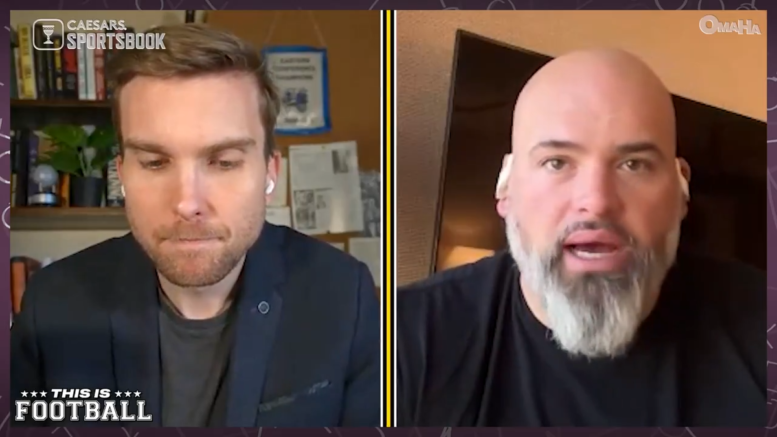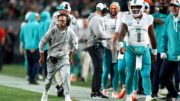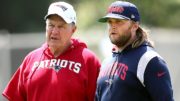The league has an offensive line problem, according to longtime lineman Andrew Whitworth.
The Super Bowl LVI champion and current Amazon broadcaster made an appearance on ESPN’s “This is Football with Kevin Clark” to discuss what Clark labeled a “crisis.” When asked if 2023 was a low point for offensive line play, Whitworth wholeheartedly agreed.
“Oh, that’s for sure,” said Whitworth, who spent 16 years in the league. “I mean I think it’s definitely not the quality of what we’ve seen. I think there’s some really good football players out there. That doesn’t mean there’s not some guys that are dominating at the offensive line position. But if you went in the totality, it’s rough. There’s a lot of weeks where you go, ‘Man, I don’t know how we can’t find another guy, or another three or four guys who are better than this.’”
Statistically measuring league-wide offensive line performance in isolation. Few publicly available data sources chart individual offensive line stats. The team stats they do are contingent on other factors, like quarterback play or defensive line success. However, even those statistics don’t indicate particularly poor offensive line play. According to data from ProFootbalReference’s Stathead, defenses are averaging 2.92 hurries per game in 2023, the second-lowest total since 2017. Total defensive pressures per game are also down to their second-lowest per-game average over that same span.
While quarterbacks are on pace to set a new career-high in sacks and sack rate, sacks are more a quarterback stat than an offensive line stat. The uptick in times sacked might be indicative of new styles of play, increases in two-high coverages, or even the sheer number of inexperienced quarterbacks forced to start games due to injury. At least from an offensive line perspective, quarterbacks have the time to throw. The average pocket time of 2.44 seconds currently ranks fourth by season since 2017.
Part of this perception problem, Whitworth notes, is that it’s also coinciding with an unprecedented crop of elite defensive line talent. 13 different players have at least 10 sacks this season. That’s the highest number of players with at least 10 sacks through this portion of the season in five years, per Stathead.
The increase in success has led to bigger paydays. Edge rushers get higher AAV contracts and more guaranteed money than tackles. Same goes for interior defensive linemen and their offensive counterparts. At least in Whitworth’s eyes, more emphasis on defensive line impact – and bigger paydays – are causing typical offensive linemen to flip to the other side of the ball.
“Really, it’s a mixture of D-linemen we’re seeing are getting more and more athletic,” said Whitworth, who played left guard and left tackle. “They’re bigger, they’re stronger. In the sense of not that they’re worse competition, but that may be some of your offensive tackles that are now playing D-tackles or defensive ends in a 3-4 that could have been left tackles. You see some of that in big, strong defensive linemen.”
Whitworth, who spent 11 years with the Bengals before joining the Rams, also hammered poor developmental cycles. He began at the college level, where he noted that the modern college offense “isn’t anything like the NFL system,” citing less of an emphasis on pass protection and general blocking. His real point of contention, though, came in offseason training. Whitworth prefaced his statement by emphasizing the need for the NFL Player’s Association’s continued emphasis on player health and safety, then argued that the league has gone “too far” in limiting player practice time.
“I think, in my opinion, we’ve gone too far in the sense that – there’s a big difference in requiring guys to come in for a long time in the offseason or to two-a-day practices and all that, and not developing people,” Whitworth argued. “I think there’s a huge difference in those two things.
“I don’t know if people understand this. When the season ends to when we begin again in late April or mid-April, you’re actually not allowed to even go in and work with your coach – even if you want to – because of PA rules. To me, if I’m a first-year, second-year, third-year player, if I want to go in the building – this is how I provide for my family, my life! This is the game and the job I want. I’m not allowed to go in and work with the person who’s employing me? That, to me, seems a little crazy. That’s a little too far.”
There is a market for offensive linemen looking to improve their skills away from the team facilities. Players can obviously hire personal trainers. Some coaches, like Duke Mayweather, specialize in offensive line development and have begun holding summits on learning and understanding offensive line play.
However, all that comes at a risk. The NFL is not liable for any salary lost to injuries that happen away from team facilities. In 2021, Broncos right tackle Ja’Wuan James tore his Achilles while working out away from the team. Denver was not held responsible for his $10 million in base salary, which contained an injury protection only activated if it occurred under team supervision. The Broncos cut James, voiding his $10 million due and an additional $5 million in 2022. James later filed a grievance, which the Broncos settled for $1.09 million.
The future of the position group
While the data may not shake out that offensive line play is down, Whitworth is absolutely right that the offensive line can dictate the future of football as we know it. You see it in the poor attempts at spring football. The more recent iterations of the XFL were held back by poor offensive line play, as was the USFL re-launch.
The dearth of talent could get even worse this offseason. The top offensive linemen hitting free agency this offseason – Tyron Smith, Dyane Brown, Kevin Zeitler, Ryan Jensen – are all well into their 30s. Jensen, the youngest of this crop, is coming off season-ending injuries. While there is a chance the 2024 draft class is historically good, it’s more of the same problem Whitworth has laid out.
Long term, the O-line drought could have the potential to kill football as we know it. The NFL is making big investments into flag football and is pushing players to try out for the 2028 U.S. Olympic flag football team. Skill position players are already the face of the league because of fantasy sports. There’s no need to block in flag, and it addresses the league’s long-established problem with concussions in contact football.
If the offensive line drought persists, and if the league doesn’t create a better developmental pipeline for offensive line talent, we may be witnessing the last of a dying breed.
Original source here
#NFL #offensive #line #problem





